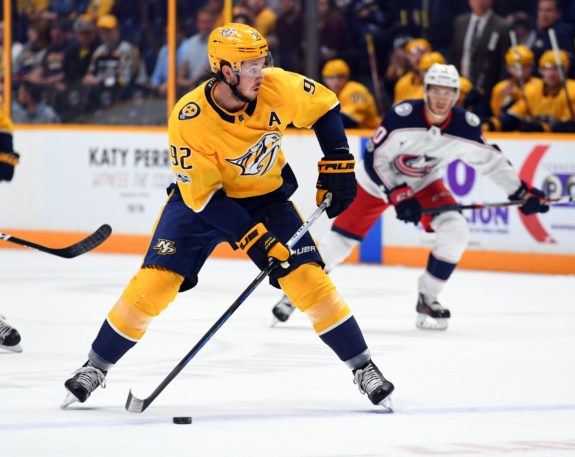The Nashville Predators’ 2018-19 season didn’t go as planned. Yes, they won the Central Division for the second straight season, but they totaled 17 fewer points than the previous season and have now exited the postseason in an earlier round two years in a row. There were numerous reasons for this: a mediocre power play, a general lack of offense, and inconsistent goaltending play. However, one player who performed well throughout the regular season was Ryan Johansen.
Johansen’s 2018-19 Season
On the surface, Johansen had an excellent 2018-19 season with 14 goals and a team-leading 64 points in 80 games. His 50 assists set a career high and his points were second-most to the 71 he totaled in 2014-15 as a member of the Columbus Blue Jackets. He had zero power play goals, but did tally 16 assists on the man advantage. He shot 10.3 percent, slightly below his career 10.6 percent mark. He was also reliable in the faceoff circle, winning 53.5 percent of draws, in line with his career average but down from the previous two seasons. His minus-23 turnover margin was the worst of his career by a large degree. Yet, in spite of those areas of regression, he still had strong possession metrics, with a 53.2 percent Fenwick.

In the postseason, Johansen struggled like most Predators forwards did. He had one goal and one assist in six games as the team’s top line of Johansen, Viktor Arvidsson, and Filip Forsberg was kept in check. Johansen was still strong at taking faceoffs (55.0 percent), but his decision-making with the puck remained problematic with a minus-nine turnover margin.
In general, his importance to the Predators cannot be overstated. He is the linchpin of the team’s top line, and if he is off, Arvidsson and Forsberg generally struggle. Considering that the team had a poor season offensively and shot just 8.8 percent, it’s amazing Johansen set a personal best in assists. Given that the Predators still don’t have a bonafide number one offensive threat and didn’t have anyone finish in the top-60 in league-wide scoring, his importance to the team is unlikely to change anytime soon.
Lack of Consistency
For as strong as Johansen’s season-end totals were, his production was inconsistent. He had a point in 45 games, or over half the games he appeared in. That’s strong production. He even started the season with a bang, and through Feb. 19, the date of his 60th game of the season, he had 53 points. However, from Game 61 through season’s end, he totaled just 11 points and he only had points in 10 of the 20 games. This inconsistency carried over to the playoffs where he only had a point in two matchups, Games 4 and 5.
Still Not a No. 1 Center
But inconsistency aside, the biggest question surrounding Johansen has been whether or not he’s a legitimate top line center. It’s a role the Predators have long needed to fill, and while Johansen had a strong 2018-19 season, he isn’t that player. Sure, by label he is the team’s top line center, and he fills his role admirably. However, when you compare him to other number one centers around the league, his abilities and production pale in comparison. For example, his 64 points last season tied for 30th among players who were centers the majority of the time. He’s behind the league’s clear-cut No. 1 centers and more in line with high-end No. 2 centers such as Joe Pavelski, Bo Horvat, and Ryan Nugent-Hopkins.

However, when you look at assists, Johansen’s 50 were 13th-most among centers and ahead of players such as Sean Monahan, Patrice Bergeron, and Tyler Seguin. Johansen is a playmaker and puck distributor, which is fine, but it’s my view that his lack of goals since joining the Predators is holding him back from being a true No. 1 pivot. The league’s best centers are capable of both making that precise pass to a teammate even when he’s covered and keeping the puck on his stick and beating the goaltender on his own. He has 26 and 33-goal seasons to his name, so he’s clearly able to score goals. If he returns to being a goal scorer, he’ll have a stronger case as a legitimate No. 1 center.
Grade: B+
In total, Johansen gets a B+ for his 2018-19 season. He paced the team in scoring and drove the Predators’ top line. He was also the only forward able to be counted on for the majority of the season. Yes, he was inconsistent at times and the team would have benefited from him being a bit more selfish with the puck, but he still had an excellent campaign. The only thing that held me back from giving him a higher grade was his low point total relative to other top line centers.
Areas for Improvement
With 2019-20 nearing, and the Predators still potentially lacking on offense, Johansen will be a key figure in the team reaching its lofty expectations. Every Stanley Cup contending team has a strong first line and when he is playing at his best, the Predators are no different. And granted, when Arvidsson and Forsberg are both playing at the top of their respective games, Johansen can get away with almost exclusively being a puck distributor. Unfortunately, Forsberg struggles with consistency and Arvidsson with injuries, so Johansen can’t exclusively be a playmaker if the Predators are going to live up to their potential. In my opinion, this means he needs to become more of a shooter this season. He averaged just 1.70 shots-per-game (S/G) last season, which, while higher than his 2017-18 rate, is continuing a trend in which he’s shot less each season.

In 2013-14 and 2014-15, his two best seasons in terms of goals, he averaged 2.89 and 2.46 S/G, respectively. While he doesn’t have to get back to those rates, he and the team could benefit from him pulling the trigger more often. This is especially true on the power play where he averaged a career-low 5.95 shots-per-60 in 2018-19. Granted, his role on the man advantage isn’t that of the shooter, but given the team’s struggles last season, Johansen posing as an additional threat can’t be a bad thing. Hopefully in 2019-20 he reverts back to being more of a scoring threat while maintaining his playmaking ability, because if he does, it will go a long way in giving the Predators a dominant top line.
*All stats from Hockey-Reference and Natural Stat Trick